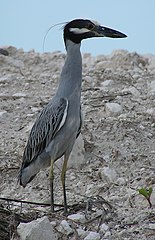Nyctanassa
Wygląd
| Nyctanassa[1] | |||
| Stejneger, 1887[2] | |||
 Przedstawiciel rodzaju – ślepowron żółtoczelny (N. violacea) | |||
| Systematyka | |||
| Domena | |||
|---|---|---|---|
| Królestwo | |||
| Typ | |||
| Podtyp | |||
| Gromada | |||
| Podgromada | |||
| Infragromada | |||
| Rząd | |||
| Podrząd | |||
| Rodzina | |||
| Podrodzina | |||
| Rodzaj |
Nyctanassa | ||
| Typ nomenklatoryczny | |||
|
Ardea violacea Linnaeus, 1758 | |||
| Synonimy | |||
| |||
| Gatunki | |||
| |||
Nyctanassa – rodzaj ptaków z podrodziny czapli (Ardeinae) w obrębie rodziny czaplowatych (Ardeidae).
Zasięg występowania[edytuj | edytuj kod]
Rodzaj obejmuje gatunki występujące w Ameryce[5].
Morfologia[edytuj | edytuj kod]
Długość ciała 51–70 cm, rozpiętość skrzydeł 101–112 cm; masa ciała 649–716 g[5].
Systematyka[edytuj | edytuj kod]
Etymologia[edytuj | edytuj kod]
- Nyctherodius: gr. νυξ nux, νυκτος nuktos „noc”; ερωδιος erōdios „czapla”[6]. Gatunek typowy: Ardea violacea Linnaeus, 1758.
- Nyctanassa (Nyctinassa): gr. νυξ nux, νυκτος nuktos „noc”; ανασσα anassa „królowa, dama”, od αναξ anax, ανακτος anaktos „król” (por. νασσα nassa „kaczka”)[7].
Podział systematyczny[edytuj | edytuj kod]
Do rodzaju należą następujące gatunki[8]:
- Nyctanassa violacea (Linnaeus, 1758) – ślepowron żółtoczelny
- Nyctanassa carcinocatactes Olson & Wingate, 2006 – ślepowron wielkodzioby – takson wymarły najprawdopodobniej na początku XVII wieku, wkrótce po skolonizowaniu Bermudów przez ludzi[9].
Uwagi[edytuj | edytuj kod]
- ↑ Niepoprawna późniejsza pisownia Nyctanassa Stejneger, 1887
Przypisy[edytuj | edytuj kod]
- ↑ Nyctanassa, [w:] Integrated Taxonomic Information System (ang.).
- ↑ L.H. Stejneger. Review of Japanese birds. V. – Ibises, storks, and herons. „Proceedings of the United States National Museum”. 10, s. 295, 1887. (ang.).
- ↑ H.G.L. Reichenbach: Avium systema naturale. Das natürliche system der vögel mit hundert tafeln grösstentheils original-abbildungen der bis jetzt entdecken fast zwölfhundert typischen formen. Vorlaüfer einer iconographie der arten der vögel aller welttheile. Dresden und Leipzig: Expedition der vollständigsten naturgeschichte, 1850, s. xvi. (niem.).
- ↑ W. Stone. On a collection of bikds obtained by the Francis E. Bond expedition in the Orinoco Delta and Paria Peninsula, Venezuela. „Proceedings of the Academy of Natural Sciences of Philadelphia”. 65, s. 193, 1913. (ang.).
- ↑ a b D.W. Winkler, S.M. Billerman & I.J. Lovette: Herons, Egrets, and Bitterns (Ardeidae), version 1.0. W: S.M. Billerman, B.K. Keeney, P.G. Rodewald & T.S. Schulenberg (red.): Birds of the World. Ithaca, NY: Cornell Lab of Ornithology, 2020. DOI: 10.2173/bow.ardeid1.01. [dostęp 2020-05-24]. (ang.).

- ↑ Nyctherodius, [w:] The Key to Scientific Names, J.A. Jobling (red.), [w:] Birds of the World, S.M. Billerman et al. (red.), Cornell Lab of Ornithology, Ithaca [dostęp 2022-01-31] (ang.).
- ↑ Nyctanassa, [w:] The Key to Scientific Names, J.A. Jobling (red.), [w:] Birds of the World, S.M. Billerman et al. (red.), Cornell Lab of Ornithology, Ithaca [dostęp 2022-01-31] (ang.).
- ↑ Systematyka i nazwy polskie za: P. Mielczarek & M. Kuziemko: Podrodzina: Ardeinae Leach, 1820 - czaple (wersja: 2023-03-12). [w:] Kompletna lista ptaków świata [on-line]. Instytut Nauk o Środowisku Uniwersytetu Jagiellońskiego. [dostęp 2023-04-21].
- ↑ BirdLife International, Nyctanassa carcinocatactes, [w:] The IUCN Red List of Threatened Species 2017, wersja 2019-3 [dostęp 2020-02-19] (ang.).
